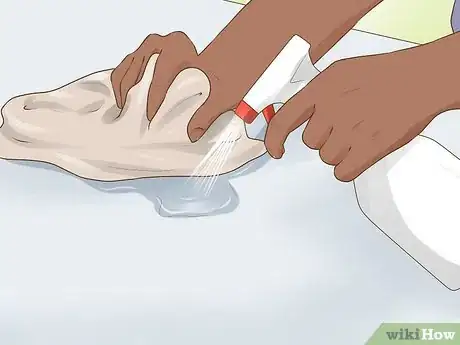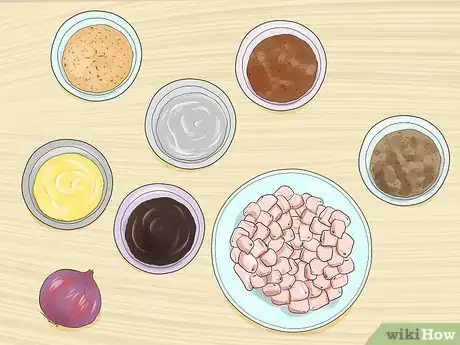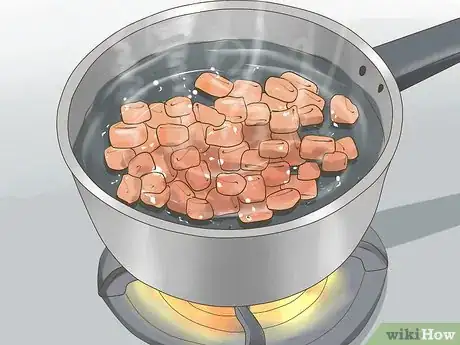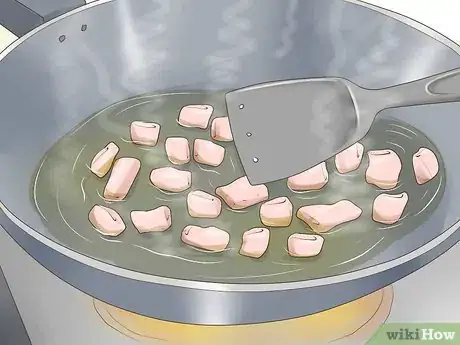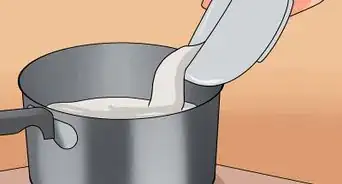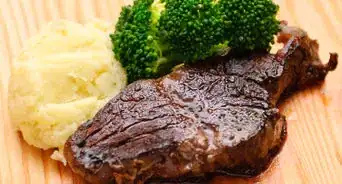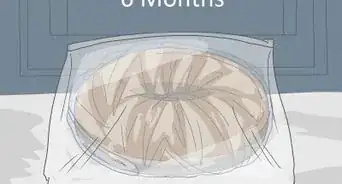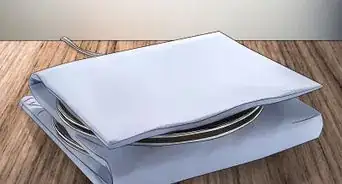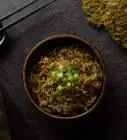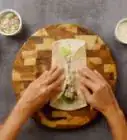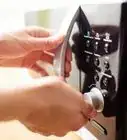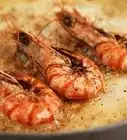This article was co-authored by wikiHow staff writer, Jessica Gibson. Jessica Gibson is a Writer and Editor who's been with wikiHow since 2014. After completing a year of art studies at the Emily Carr University in Vancouver, she graduated from Columbia College with a BA in History. Jessica also completed an MA in History from The University of Oregon in 2013.
wikiHow marks an article as reader-approved once it receives enough positive feedback. In this case, 88% of readers who voted found the article helpful, earning it our reader-approved status.
This article has been viewed 119,191 times.
Learn more...
You've probably heard of chitlins, a Southern specialty. Chitlins are also known as chitterlings, the small intestines of pigs. You can boil or fry chitlins after preparing them safely. Since the intestines can carry bacteria, it's important to thoroughly clean them before cooking and serving them. You'll need to spend some time cleaning the chitterlings and sanitizing your kitchen to prevent the spread of disease.
Steps
Preparing Chitterlings Safely
-
1Purchase your chitterlings. You can find chitterlings at some supermarkets or purchase them directly from a butcher. Always buy about twice as many chitterlings than you want to end up with. Chitterlings shrink when boiled and cooked, so you'll end up with fewer chitterlings than you started with.[1]
- You'll need to clean the chitterlings even if the kind you purchase say they've been pre-cleaned.
-
2Do not prepare chitterlings around children. If you have small children, have someone else watch them. Children are at a higher risk for bacterial disease that can be spread by raw chitterlings. Minimize their risk of illness by having another person care for them while you clean the chitterlings.[2]
- Avoid touching or holding your baby while handling the raw chitterlings to prevent spreading bacteria.
- You should also take care to clean any baby bottles, kid food storage, or place mats that may come into contact with the chitterlings.
Advertisement -
3Boil the chitterlings. To begin cleaning your chitterlings, place them in a large pot with fresh water. Bring the chitterlings to a boil over high heat. Boil the chitterlings for 5 minutes. Boiling the chitterlings kills bacteria in the chitterlings. Wash your hands immediately after handling the raw chitterlings.
- If you're using frozen chitterlings, thaw them before cleaning them.
-
4Sanitize your kitchen space. As the chitterlings boil, prepare a sanitizing mixture. In a large bucket, combine 1 tablespoon of bleach with 1 gallon of water. Dip a clean wash cloth in the sanitizer and wipe down everything in the kitchen that came into contact with the raw chitterlings.
- You can also pour some of the sanitizer into a clean spray bottle. Spray down kitchen surfaces and use a clean dry cloth the wipe the surfaces clean.
-
5Examine each chitterling. Drain the boiled chitterlings into a large colander in your sink. Once the chitterlings are cool enough to handle, sort through each chitterling and look for foreign materials (like straw, skin,or hair), undigested food, and fecal matter. Throw away any of this debris.
- Wear oven mitts and be careful when handling boiling water.
-
6Rinse and cut the chitterlings. Rinse the chitterlings with lots of cool water so that any debris is washed away. Do this for several minutes or until the chitterlings are completely clean. Cut or tear the chitterlings into large pieces.[3]
- While you can cut the chitterlings to any size you'd like, most people cut them in 1/2" to 1" pieces.
- Remember to sanitize your kitchen again after handling the raw chitterlings. Don't forget to wash the colander and your sink.[4]
Boiling and Serving Chitterlings
-
1Gather your basic ingredients. Most chitterling recipes call for boiling chitterlings with water, vinegar, and onion for several hours. For a basic flavorful chitterling recipe, you'll need:[5]
- 10 pounds of cleaned chitterlings
- 1 medium to large onion, chopped or sliced
- 1 to 1 1/2 cups of white vinegar
- A few tablespoons of ground pepper or lemon pepper
- 1/4 cup of fresh lemon juice
- 2 cloves of fresh garlic or a few dashes of garlic powder
- Seasoning salt
- A few dashes of soy sauce
-
2Bring your ingredients to a boil. Put all of your ingredients in a large pot. You can use a soup pot or a large cast iron pot. Just make sure that it has a lid. Add enough water to cover the top of your chitterlings. Cover the pot and boil the chitterlings for three hours. Serve the chitterlings immediately or you can cover and refrigerate them to serve later.
- Check the pot every once in a while and add more water if the chitterlings begin to dry out. They should always be covered with water.
-
3Spice up your chitterlings. While the most basic chitterlings recipe is just water, onions, vinegar, and chitterlings, you can easily add unique flavors or ingredients to make your own personal chitterlings recipe. Consider adding some of the following ingredients before you boil the chitterlings:[6]
- Red pepper flakes
- Jalapeno peppers
- Celery
- Bell pepper
- Bay leaf
- Creole seasoning
- One potato, whole or sliced
Frying and Serving Chitterlings
-
1Clean and boil the chitterlings. Clean the chitterlings and cook the chitterlings by boiling them with an onion and seasonings. Cook the chitterlings until they're tender (about 2 hours). Rinse them under cold running water.[7]
- You'll need to pre-cook your chitterlings before frying them. This will ensure they're safe to eat and tender before you fry them.
-
2Coat the chitterlings with batter. Create a batter by beating 1 egg with 1 tablespoon of water in a shallow bowl. Place fine cracker crumbs in another shallow bowl. Dip each chitterling into the egg mixture. Lay the egg-coated chitterling in the cracker crumbs so it's completely coated.[8]
- You can create dredging stations. On the counter next to the pot, set up the bowl with the egg mixture next to the bowl with the cracker crumbs.
-
3Fry the chitterlings. Heat several inches of oil in a large pot. Once the oil heats up to 370 degrees F, add several chitterlings to the oil. Fry the chitterlings until they're golden brown and crisp on the outside. Carefully remove the chitterlings from the oil and continue cooking the remaining chitterlings until they're all cooked and golden. Serve them immediately.[9]
- Avoid cooking all of the chitterlings at once. This would lower the oil's temperature too quickly and the chitterlings wouldn't fry properly.
Community Q&A
-
QuestionHow do you keep from gagging while the chitterlings are cooking?
 Community AnswerRub your nostrils with soy sauce; it blocks the smell very well.
Community AnswerRub your nostrils with soy sauce; it blocks the smell very well. -
QuestionAfter boiling water, how do I clean and cut chitterlings?
 Community AnswerPlace in cold water and pull the fat and debris out of the inside. Turn them inside out if possible, and be mindful to remove any brown discoloration. Move clean chitterlings to a clean container as you work. It takes at least 2 passes.
Community AnswerPlace in cold water and pull the fat and debris out of the inside. Turn them inside out if possible, and be mindful to remove any brown discoloration. Move clean chitterlings to a clean container as you work. It takes at least 2 passes. -
QuestionCan you get sick from eating chitterlings?
 Community AnswerYes, you can get sick if the chitterlings have been contaminated with Yersinia enterocolitica, Salmonella, and E. coli. It is vital that you clean the chitterlings thoroughly.
Community AnswerYes, you can get sick if the chitterlings have been contaminated with Yersinia enterocolitica, Salmonella, and E. coli. It is vital that you clean the chitterlings thoroughly.
Warnings
- If you or a child in your house develops a fever, has appendicitis-like stomach pain, and bloody diarrhea, get medical attention. These are signs of enterocolitis, a bacterial disease, that can begin 3 to 7 days after coming into contact with bacterial from chitterlings.⧼thumbs_response⧽
References
- ↑ https://delishably.com/meat-dishes/How-to-Cook-Chitlins-Chitterlings
- ↑ http://chronicle.augusta.com/stories/1996/12/09/foo_201107.shtml#.V5_FlLgrLIU
- ↑ https://delishably.com/meat-dishes/How-to-Cook-Chitlins-Chitterlings
- ↑ http://www.fsis.usda.gov/wps/portal/fsis/topics/food-safety-education/get-answers/food-safety-fact-sheets/foodborne-illness-and-disease/yersiniosis-and-chitterlings/ct_index
- ↑ https://delishably.com/meat-dishes/How-to-Cook-Chitlins-Chitterlings
- ↑ https://delishably.com/meat-dishes/How-to-Cook-Chitlins-Chitterlings
- ↑ http://www.soulfoodandsoutherncooking.com/chitterlings-recipe.html#sthash.g0wY6eQA.dpuf
- ↑ http://www.soulfoodandsoutherncooking.com/chitterlings-recipe.html#sthash.g0wY6eQA.dpuf
- ↑ http://www.soulfoodandsoutherncooking.com/chitterlings-recipe.html#sthash.g0wY6eQA.dpuf
About This Article
Before cleaning chitterlings, boil them in a pot of water to kill the bacteria, then drain them in a large colander in the sink. Next, wash your hands and sanitize all the kitchen surfaces that came into contact with the chitterlings by wiping them down with a solution of bleach and water. Once the chitterlings are cool enough to handle, sort through them and dispose of any debris such as straw, skin, and hair. Then, rinse them with cool water for several minutes, or until all the chitterlings are completely clean. For more advice, including how to cook and serve your chitterlings after cleaning them, keep reading.



